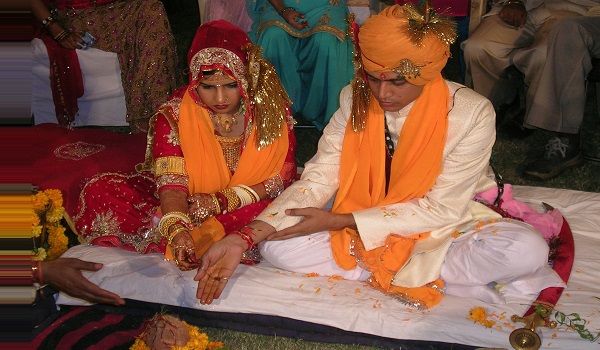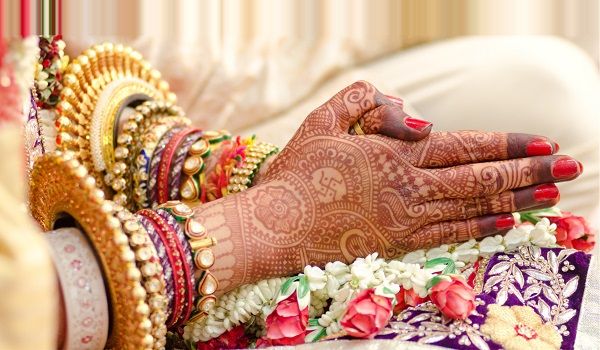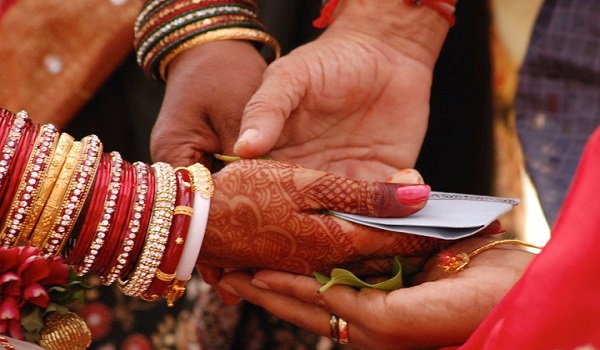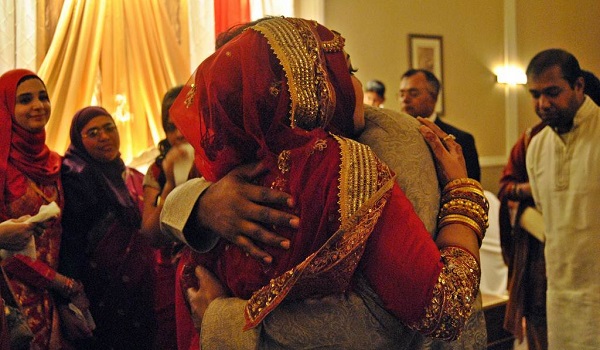
Image Source: vimeo.com
Marriages, according to Hindu beliefs are made in heaven, and once you are married, the bond is supposed to last for seven lifetimes. It is considered to be a turning point in an individual’s life as he enters the second important phase or ashram of his life – the ‘Garhasthyaashram’. A lot of importance is associated with marriages in Hinduism as it is considered to be one of the most important duties of a man’s life. Through marriage he is paying his debt to his forefathers, by procreating children and ensuring continuation of his family’s lineage. Hindu weddings are long processes, with various rituals that may take days to be executed. Every single custom and practice in a wedding ceremony has deep philosophical and spiritual significance. Throughout the world the Hindus adhere to these set of rituals and continue on the traditions of marriage that is unique amongst those in the world.
Types of Weddings
According to Hindu sacred texts like Asvalayana Garhyasutra and Atharvaveda, eight different types of marriages are recognized by the ancient Hindu society. Four of them were categorized as ‘Prashasta’ or proper marriages conducted by following appropriate religious customs. The remaining four were considered as ‘Aprashasta’, which referred to inappropriate unions between man and woman that did not follow any Vedic or religious ritual.
The various types of Prashasta marriages are as follows -
Brahma– It is the marriage that takes place upon receiving mutual consent from both bride and groom’s families. It is considered the most appropriate form of marriage in Hindu society.
Daiva – The daughter is dressed up with fine clothes and ornaments and is offered as a sacrifice fee to the Deity. This type of weddings was prevalent during yajna sacrifices in ancient times.
Arsha – The father gives away his daughter in exchange for a cow and a bull from the groom’s family. The groom takes an oath to effectuate his commitment towards the bride and her family.
Prajapatya – Here the couple get married by uttering Sanskrit verses promising eternal love in presence of their families. This is similar to a modern day civil ceremony where neither priest nor religious rites are performed.
The various types of Aprashasta marriages are –
Gandharva – The bride and the groom either start living together as a couple out of love and mutual consent or get married without a formal ceremony as well as without the consent of their families.
Asura – In this type of marriage, the bride’s father has been intimidated or bribed by the groom or his family into giving his consent to giving up his daughter for marriage.
Rakshasha – In these types of marriage the bride is forced into marrying against her consent.
Paisacha – This is the most brutal of all types of marriages, where the groom forces himself upon the bride first and then accepts her as his bride.
The last two types of marriages were not only indecorous but also religiously impermissible.
Hindu marriages are based on age old traditions that have been translated into laws. According to traditions, a Hindu marriage cannot be reversed and is irrevocable. The modern day Hindu Marriage laws prohibit Polygamy or Polyandry. In India as well as most Hindu cultures across the world, arranged marriages are still the most preferred way of getting hitched. Consent and happiness of the families are of utmost important in Hindu culture as the marriage not only union of two souls, but also union of two families.

Variations in Hindu Weddings across India
Weddings among Hindus in India are a set of complex customs and vary considerably from region to region. Each community has their own spin on the basic Hindu wedding ceremony based on geographical location and cultural influences. While in some communities, it is a simple but elegant affair, in others, weddings spell grandeur and pomp. In North India the wedding proceedings are generally termed as ‘Vivah Sanskar’ whereas in most of South India it is referred to as ‘Kalyanam’. Hindu weddings are basically a Yajna ritual with the Fire Deity or Agni as the primary witness. The rituals are primarily handled and carried out along with Sanskrit Mantras, according to guidelines laid down thousands of years ago by sages who created the Vedas. In some cultures weddings take place during daytime, while in others they are held only after sunset. In some communities like the Kerala Nairs weddings are matrilineal instead of patriarchal which the norm is almost everywhere else. While most north Indian weddings are big on fun, frolic and colors, weddings in South India are comparatively demure and modest.
Although, there are countless variations across the country when it comes to wedding rituals, but among most Hindu communities, weddings are elaborate events with multiple rituals being observed throughout many days. The common theme of all different versions is the fervor along with a proclivity towards adherence to traditions. Also involvement of the extended family and friends are must in Indian Hindu weddings. There are certain common pre-wedding, wedding day and post-wedding customs that are generally observed by all Hindus.

Pre-wedding Rituals
As arranged marriages are still the primary mode of marriage among Hindu, pre-wedding ceremonies are directed towards finding the perfect match by a prospective bride or groom’s families. That is either through a family friend or a professional matchmaker, or from a modern perspective through matrimonial sites. Even in the context where the couples who are going for a love marriage, the two families are to be introduced to each other and agree upon the finer points of the impending union. Most communities stress upon a horoscope matching before proceeding further in an arranged marriage. If the stars of the boy and girl are in perfect harmony, then the marriage talks proceed further. The two families meet to discuss the finer details of the impending event. A date is fixed when the formal announcement of the wedding will take place. This is generally known as the Engagement ceremony.
The engagement ceremony is known by many names – Sagai in Haryana, Roka in Punjab, Sakhar Puda in Maharashtra, Kasamdry among Kashmiri Pandits, Tilak among Marwaris, Nishchayam or Nishchaya Thamboolam in South India and Ghor Dana among Gujaratis. Exchange of rings may take place in some cultures between the bride and groom-to be. But there is almost always an exchange of gifts between the two families symbolizing acceptance of the match and as a gesture of welcoming into each other’s families. In most cases, the date of the wedding is decided on the day of the engagement ceremony. Generally there is a gap of a few months between the engagement and the wedding for the families to prepare for the big day. As the wedding day approaches, there are a few rituals that are observed like Ganesh Puja, Mehendi, Sangeet and Haldi.
In most cultures, a Puja is held by both the bride and groom’s families. The families pray to Lord Ganesha to remove all obstacles from the couple’s life path.

Mehendi is mostly a North Indian tradition where a paste of henna is applied on the bride’s and groom’s hands. For the bride the designs are intricate, elaborate and artistic. Women in the family gathers and get henna designs applied to their hands as well. Nowadays other cultures like Bengalis and South Indians have also adopted this tradition of applying Mehendi before wedding. The Sangeet is a fun-filled ceremony where both the families get together to perform song-dance routines, and get to know each other better. This is a predominantly North Indian practice as well, especially among Punjabis and Gujaratis, but has been widely adopted by other cultures as well. The Haldi ceremony is a very common ritual among almost all communities in India. Turmeric is ground to a paste along with other ingredients that vary from culture to culture. This paste in applied to both the bride’s and groom at their respective places by women elderly members of their families before they are washed by sacred water. The Haldi Ceremony is known by many a name across the country, Gaye Holud among Bengalis, Pithi among Gujaratis and Mangala Snanam among Tamilians.

Image Source http://weddings.iloveindia.com
Wedding Rituals
The key steps of Hindu wedding ritual are Kanyadaan and Paanigrahan, Vivaah Homa, Laja Homa and Agni Pradakshina, and finally Saptapadi according to Grihya sutras. Other rituals vary according to regional cultures but these are the key steps of a Hindu Marriage without which the marriage would not be considered complete. Traditionally, the bride’s parents host the wedding ceremony and the groom and his family are the guests arriving from outside to the Mandap. The whole wedding ceremony sort of depicts a story of first meeting of the bride and the groom at the wedding mandap, the bride’s parents giving her away to this worthy man, the couple committing to each other in front of the sacred fire followed by the couple taking the seven vows of commitment to the marriage and the friends and families blessing the newly wedded couple.
The groom arrives at the bride’s house and he is welcomed by the bride’s parents first with an arti, then by feeding a drink of milk and honey known as Madhu Parka ceremony and finally before he arrives at the mandap the bride’s father washes the groom’s feet. The bride arrives at the mandap and the couple lay their eyes on each other. These rituals are presented in various forms among different Indian communities.

The father of the bride then gives her away to the groom in a ceremony known as Kanyadaan. The left hand of the bride is placed on the groom’s right hand and the bride’s parents utter the following words while giving her away ‘Today, the bride is Laxmi and the groom is Vishnu. By joining their hands in marriage, we will repay the debt to our forefathers by continuing the next life cycle.’ Kanyadaan is considered to be the noblest act of offering that a person can perform and by doing it the parents of the bride are absolved of all their bad karmas. The groom accepts the bride’s hand and they promise each other that while pursuing a life of Dharma, Artha and Kama, they will remain faithful to each other. This is known as Paanigrahan.

Image Source: Weddingmagazine.in
Next the sacred fire is lit at the center of the wedding mandap and is considered to be the prime witness of the marriage rituals. The couple feed ghee to the fire as offering and prays to the Gods for Santati (children), Sampatti (wealth & prosperity) and Deergharogya (long and healthy lives). This is known as the Vivaha Homa. During the Laja Homa, the bride’s brother pours rice on her palms and the couple offers it to the sacred fire together. The ends of their garments are tied in a knot and they perform Agni Pradakshina where they make seven circles around the Sacred Fire uttering the promise to each other to be eternal partners and complement each other in life’s journey. At the end of the seventh circle the bride moves to the left side of the groom indicating that she is now part of his life. The final most important ritual in a Hindu Wedding is the Saptapadi or the Seven Sacred Vows. The bride takes seven symbolic steps while pushing a stone along the floor with her left foot while the groom assists her. They reiterate the aspirations of their married life as each step signifies a specific promise that the couple make to each other which are as follows –
- First step: To respect and honor each other
- Second step: To share each other’s joy and sorrow
- Third step: To trust and be loyal to each other
- Fourth step: To cultivate appreciation for knowledge, values, sacrifice and service
- Fifth step: To appreciate purity of emotions, love, family duties and spiritual growth
- Sixth step: To follow principles of Dharma
- Seventh step: To nurture an eternal bond of friendship and love
On completion of this ritual the marriage is concluded and the couple seeks blessings from elders of the families.
Post-wedding Rituals

Image Source: shayari7.com
The post wedding rituals primarily comprises of Vidaai, welcoming of the bride at the groom’s house and reception. During the Vidaai ceremony the family of the bride gives her an emotional send-off and the bride throws back three handfuls of rice and coin over her shoulders to signify end of her debt to her parents for nurturing her and wishing prosperity upon them.
On the arrival at the groom's house, the new couple is welcomed by the groom's mother, with a traditional aarti. The bride enters her in-laws house by displacing a container filled with rice signifying that she is the bringer of abundance to her new family. She then dips her feet in a mixture of red vermillion and enters the house, leaving foot prints on the floor. This ritual is practiced as the bride is considered as a form of Goddess Laxmi. After this, a number of wedding games are played to make the bride comfortable.
A reception is either organized by the bride’s family after the wedding rituals have been completed to feed guest and get them to bless the couple. Or in some cultures it is arranged by the groom’s family after the bride has arrived from her paternal home.




